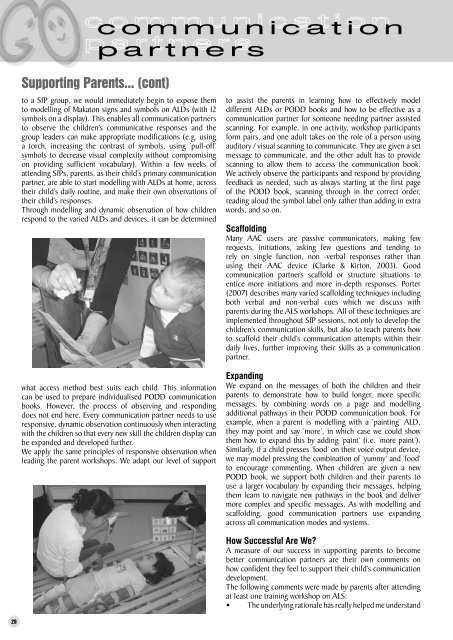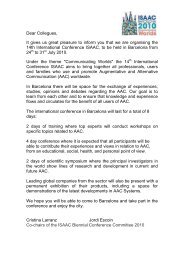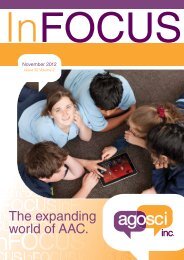May 2008 Edition - agosci
May 2008 Edition - agosci
May 2008 Edition - agosci
You also want an ePaper? Increase the reach of your titles
YUMPU automatically turns print PDFs into web optimized ePapers that Google loves.
ccommunicationo m m u n i c a t i o nppartnersa r t n e r sSupporting Parents... (cont)to a SfP group, we would immediately begin to expose themto modelling of Makaton signs and symbols on ALDs (with 12symbols on a display). This enables all communication partnersto observe the children’s communicative responses and thegroup leaders can make appropriate modifications (e.g. usinga torch, increasing the contrast of symbols, using ‘pull-off’symbols to decrease visual complexity without compromisingon providing sufficient vocabulary). Within a few weeks ofattending SfPs, parents, as their child’s primary communicationpartner, are able to start modelling with ALDs at home, acrosstheir child’s daily routine, and make their own observations oftheir child’s responses.Through modelling and dynamic observation of how childrenrespond to the varied ALDs and devices, it can be determinedwhat access method best suits each child. This informationcan be used to prepare individualised PODD communicationbooks. However, the process of observing and respondingdoes not end here. Every communication partner needs to useresponsive, dynamic observation continuously when interactingwith the children so that every new skill the children display canbe expanded and developed further.We apply the same principles of responsive observation whenleading the parent workshops. We adapt our level of supportto assist the parents in learning how to effectively modeldifferent ALDs or PODD books and how to be effective as acommunication partner for someone needing partner assistedscanning. For example, in one activity, workshop participantsform pairs, and one adult takes on the role of a person usingauditory / visual scanning to communicate. They are given a setmessage to communicate, and the other adult has to providescanning to allow them to access the communication book.We actively observe the participants and respond by providingfeedback as needed, such as always starting at the fi rst pageof the PODD book, scanning through in the correct order,reading aloud the symbol label only rather than adding in extrawords, and so on.ScaffoldingMany AAC users are passive communicators, making fewrequests, initiations, asking few questions and tending torely on single function, non -verbal responses rather thanusing their AAC device (Clarke & Kirton, 2003). Goodcommunication partners scaffold or structure situations toentice more initiations and more in-depth responses. Porter(2007) describes many varied scaffolding techniques includingboth verbal and non-verbal cues which we discuss withparents during the ALS workshops. All of these techniques areimplemented throughout SfP sessions, not only to develop thechildren’s communication skills, but also to teach parents howto scaffold their child’s communication attempts within theirdaily lives, further improving their skills as a communicationpartner.ExpandingWe expand on the messages of both the children and theirparents to demonstrate how to build longer, more specifi cmessages, by combining words on a page and modellingadditional pathways in their PODD communication book. Forexample, when a parent is modelling with a ‘painting’ ALD,they may point and say ‘more’, in which case we could showthem how to expand this by adding ‘paint’ (i.e. ‘more paint’).Similarly, if a child presses ‘food’ on their voice output device,we may model pressing the combination of ‘yummy’ and ‘food’to encourage commenting. When children are given a newPODD book, we support both children and their parents touse a larger vocabulary by expanding their messages, helpingthem learn to navigate new pathways in the book and delivermore complex and specifi c messages. As with modelling andscaffolding, good communication partners use expandingacross all communication modes and systems.How Successful Are We?A measure of our success in supporting parents to becomebetter communication partners are their own comments onhow confi dent they feel to support their child’s communicationdevelopment.The following comments were made by parents after attendingat least one training workshop on ALS:• The underlying rationale has really helped me understand26





